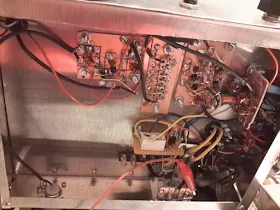A while back, when I first mentioned getting on 160 meters by year's end, Pete suggested I shoot for Straight Key Night. As many of you know, suggestions from Pete somehow seem to have a way of becoming ham radio MORAL IMPERATIVES. He seems to be a prophet of sorts, a prophet of THE RADIO GODS. So following the guidance of the oracle of Newbury Park, I found myself in front of my DX-100/HQ-100 on New Year's Eve, on 160 meter CW for the first time in my 42 years as a radio amateur.
It was great. A couple hours prior to the official 0000Z start of Straight Key Night I had my first 160CW QSO. It was with John WA2MUA up in Summit, NY. John's QRZ page includes this: “Years
ago--as a teenager-- in an attempt to get enough wire for 160 I wrapped a
quarter wave of wire around a pvc pipe, strapped it to a wooden
gutter----burned a large notch in the gutter and could have burned my
parents' house down!” That, my friends, is 160 meter KNACK!
Then, just minutes after SKN kick-off, I worked John W3LR in Eastern Pennsylvania. It was also John's first SKN contact.
Next up was Eric NO3M. Wow, this one was amazing. Eric was running the homebrew rig pictured above. On his blog Eric describes the rig: "The transmitter is running a 89 Clapp oscillator, 802 buffer, 811 final... Output power is approximately 75W. "
Eric's antenna is even more amazing: it is a 160 meter four square featuring FOUR aluminum tubing vertical elements with capacity hats and --GET THIS -- a radial field consisting of 22,000 feet of bare copper wire. TWENTY TWO THOUSAND FEET OF BARE COPPER WIRE. Wow, you just don't run into stations like that on 20 meter sideband. Eric's blog: http://no3m.net/ But Eric -- a Vibroplex Champion? On SKN?
I then worked KC2LSD and K1EEE. FB!
My last contact of the evening (and the year) was K1WHS, Dave in Maine. On his QRZ.com page, Dave reports:
“On
160 meters, I have a small setup right at my house. I use a K3 with a homebrew
3-1000 amplifier that runs at 1300 watts. The antenna is an 80 ft Rohn 25 in my
backyard with some top loading and shunt feeding. I laid out a bunch of
radials in an effort to get the efficiency up. At last count I had about 107
1/4 wave radials strung out. 160 is the only band where my feedline is not big
fat hardline. I use a run of RG-213. For receive, I have several
beverages running in the woods. I use this setup often in the winter as many
times, the hilltop shack is not accessible due to heavy snow. I have
nothing up for any of the bands between 160 and 10 meters”.
Thanks to all of my SKN contacts! And Happy New Year to all SolderSmoke readers and listeners!

































